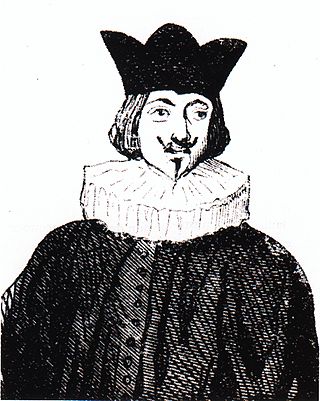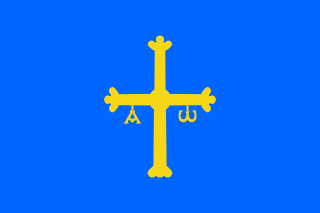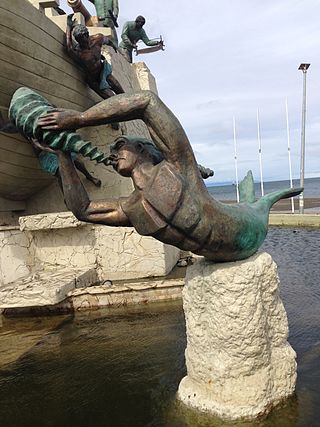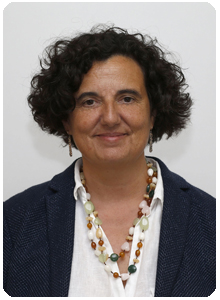
Asturleonese is a Romance language or language family spoken in northwestern Spain and northeastern Portugal, namely in the historical regions and Spain's modern-day autonomous communities of Asturias, northwestern Castile and León, Cantabria and Extremadura, and in Riudenore and Tierra de Miranda in Portugal. The name of the language is largely uncommon among its native speakers, as it forms a dialect continuum of mutually intelligible varieties and therefore it is primarily referred to by various regional glossonyms like Leonese, Cantabrian, Asturian or Mirandese. Extremaduran is sometimes included as well. Asturleonese has been classified by UNESCO as an endangered language, as the varieties are being increasingly replaced by Spanish and Portuguese.

The xana is a character found in Asturian mythology. Always female, she is a creature of extraordinary beauty believed to live in fountains, rivers, waterfalls, or forested regions with pure water. The origin of the Asturian word xana is unclear, though some scholars see it as a derivation from the Latin name for the goddess Diana. References to where the mythological xanas lived are still common in Asturian toponyms. They also appear in Eastern Galician and Cantabrian mythology (Anjanas).

The Academia de la Llingua Asturiana or Academy of the Asturian Language (ALLA) is an Official Institution of the Government of the Principality of Asturias that promotes and regulates the Asturian language, a language of the Spanish autonomous community of Asturias. Among its principal objectives are investigating and normalising the Asturian Language, developing a dictionary, promoting its use and education and awarding literary prizes. It has 21 full members, 19 foreign members and 15 honorary members, and its current president is Ana María Cano González.

Leonese is a set of vernacular Romance language varieties currently spoken in northern and western portions of the historical region of León in Spain and a few adjoining areas in Portugal, where it is known as Mirandese, sometimes considered another language. In the past, it was spoken in a wider area, including most of the historical region of Leon. The current number of Leonese speakers is estimated at 20,000 to 50,000.

Antón González Reguera, better known as Antón de Marirreguera was the author of the first preserved literary works written in the Asturian language, the «Pleitu ente Uviéu y Mérida pola posesión de les cenices de Santa Olaya», of 1639, that takes the first prize in a poetical contest dedicated to Saint Eulalie. Other works include the «Diálogu políticu», the fables «Dido y Eneas» and «Hero y Lleandro» and the entremeses «L'ensalmador» (The Healer, «L'alcalde» and «Los alcaldes».

Asturian is a West Iberian Romance language spoken in the Principality of Asturias, Spain. Asturian is part of a wider linguistic group, the Asturleonese languages. The number of speakers is estimated at 100,000 (native) and 450,000. The dialects of the Astur-Leonese language family are traditionally classified in three groups: Western, Central, and Eastern. For historical and demographic reasons, the standard is based on Central Asturian. Asturian has a distinct grammar, dictionary, and orthography. It is regulated by the Academy of the Asturian Language. Although it is not an official language of Spain it is protected under the Statute of Autonomy of Asturias and is an elective language in schools. For much of its history, the language has been ignored or "subjected to repeated challenges to its status as a language variety" due to its lack of official status.
Manuel Asur is a Spanish essayist and poet in Asturian. He's considered to be one of the first modern poets in this language. He has a PhD degree in Philosophy. His book, Cancios y poemes pa un riscar meant the beginning in 1977 of the rebirth of asturian literature, because he contributed with a poetry more newfangled and risked than anything written before in this language. Most of their works talk about the socio-political facts of the moment. Some of their poems became very popular in Asturias in the 1970s since the group Nuberu used them as lyrics for their songs. He wrote also a narrative book in 1987, Hai una llinia trazada, with short stories that he say to consider "almost monologues". He's a current articulist of La Nueva España publications and works in the Consejería de Medio Rural y Pesca del Principado de Asturias.
Adolfo Camilo Díaz López is a Spanish writer in asturian language. He is specially known as a playwright and author of short novels. He had achieved some of the most important prizes of the Asturian literature, as the Xosefa Xovellanos of novel or the short novel prize of the Academia de la Llingua Asturiana.

Belmonte de Miranda is a municipality in the Autonomous Community of the Principality of Asturias, Spain. It is bordered on the north by Salas, on the east by Grado, to the south by Somiedo and Teverga, and on the west by Tineo.

Candamo is a municipality in the Autonomous Community of the Principality of Asturias, Spain. It is bordered on the east by Las Regueras, on the south by Grado, on the north by Illas, Castrillón and Soto del Barco, and on the west by Pravia and Salas.
The Chilote mythology or Chilota mythology is formed by the myths, legends and beliefs of the people who live in the Chiloé Archipelago, in the south of Chile. This mythology reflects the importance of the sea in the life of Chilotes.

Asturians are a Romance ethnic group with Celtic roots, native to the autonomous community of Asturias, in the North-West of the Iberian Peninsula.

The Anjana are one of the best-known fairies of Cantabrian mythology. These female fairy creatures foil the cruel and ruthless Ojáncanu. In most stories, they are the good fairies of Cantabria, generous and protective of all people. Their depiction in the Cantabrian mythology is reminiscent of the lamias in ancient Greek mythology, as well as the xanas in Asturias, the janas in León, and the lamias in Basque Country, the latter without the zoomorphic appearance.
The Guajona or Lumia is a mythological creature in Cantabrian legend, resembling a disfigured human female. It is thought to resemble one of the many forms of witches and hags of medieval Europe.

Asturian literature is the writings in the Asturian language of the northwest Iberian Peninsula. The earliest documents date back to the 10th century, but the peak period of literary output was in the 18th century, with a late 20th century revival.

Asturian Nationalist Council, was a political party in Asturias, Spain. The CNA was Asturian nationalist and socialist party.

Millalobo is an important being in Chilote mythology. He is the most powerful being of the sea after Caicai and was chosen by Caicai to be his representative and govern all that resided in the sea.

The movement for the officiality of the Asturian language, also known as the movement for the officiality is the social movement present in Asturias that demands that the Statute of Autonomy of the Principality of Asturias give Asturian the same role as Spanish, like it occurs in other Autonomous Communities with its own language.
Pablo Xuan Manzano Rodríguez a scholar of Asturian language. He carried out his basic education in his home village and later on he studied teaching in the University School of Oviedo. He started to work at the age of 20 in the school of L'Entregu, and afterwards he also worked in Gijón, Amieva and Campo de Caso before he started working in the Juan José Calvo Miguel High School in Sotrondio. He is a member of the Council of Asturian Communities representing the Academy of the Asturian Language, of which he has been a fellow since 1984.

Berta Piñán Suárez is an Asturian writer, professor of Spanish Language and Literature, full member of the Academy of the Asturian Language, and since July 25, 2019, Minister of Consejería de Cultura, Política Lingüística y Turismo del Principado de Asturias.














